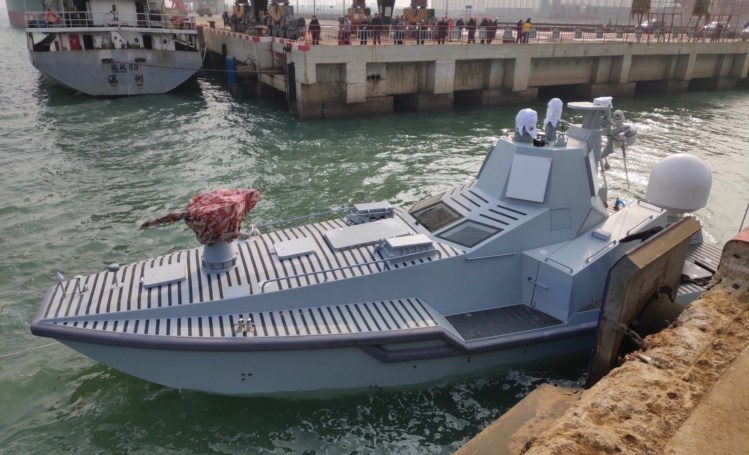The following article first appeared on Warrior Maven, a Military Content Group member website.
(Washington, DC) US Navy Unmanned Surface Vehicles continue to reach paradigm-changing levels of autonomous navigation, networking and multi-domain operational capacity. The service is successfully building Small, Medium and Large USVs with algorithms for many independent functions, radar and weapons and new generation of interfaces to enable joint connectivity. Small USVs emerged for the Navy many years ago, and the service has in recent years made breakthrough progress with medium and large USVs as well, unmanned vessels which will be armed with a clear understanding that any decision about the use of lethal force will be made by a human being. However, the ships are being engineered with new generations of algorithms sufficient to enable many more functions independently without human intervention, such as intelligence collection and processing, targeting and information transmission across air-sea-and -ground “nodes” within a multi-domain network. US Navy USVs are increasingly able to coordinate autonomous activities and share information in relation with one another as part of an integrated mission to assess an enemy perimeter, identify and pass along targeting information or engage in highly networked mine and submarine hunting.
How Far Along is China?
Given the scope of US Navy progress in the area of autonomous surface warfare and fast-expanding fleet of drone warships, it comes as no surprise to learn that the large and closely followed Chinese Navy is reporting success with the same thing.
As far back as several years ago, the Chinese Communist Party-backed Global Times newspaper says a new Chinese unmanned high-speed vessel demonstrated “breakthrough” levels of “dynamic cooperative confrontation technology.” This language, according to the paper, suggests that the Chinese USVs can “quickly intercept, besiege and expel invasive targets.”
This technology is brought to fruition through advanced levels of collaborative autonomy wherein advanced algorithms are able to process incoming data, bounce it off a vast database to perform analyses and optimize a course of action. The Chinese paper describes it as “collaborative perception, high-speed tracking, evidence collection, interception and guarding Chinese sea territory.”
The following article first appeared on Warrior Maven, a Military Content Group member website.
(Washington, DC) US Navy Unmanned Surface Vehicles continue to reach paradigm-changing levels of autonomous navigation, networking and multi-domain operational capacity. The service is successfully building Small, Medium and Large USVs with algorithms for many independent functions, radar and weapons and new generation of interfaces to enable joint connectivity. Small USVs emerged for the Navy many years ago, and the service has in recent years made breakthrough progress with medium and large USVs as well, unmanned vessels which will be armed with a clear understanding that any decision about the use of lethal force will be made by a human being. However, the ships are being engineered with new generations of algorithms sufficient to enable many more functions independently without human intervention, such as intelligence collection and processing, targeting and information transmission across air-sea-and -ground “nodes” within a multi-domain network. US Navy USVs are increasingly able to coordinate autonomous activities and share information in relation with one another as part of an integrated mission to assess an enemy perimeter, identify and pass along targeting information or engage in highly networked mine and submarine hunting.
How Far Along is China?
Given the scope of US Navy progress in the area of autonomous surface warfare and fast-expanding fleet of drone warships, it comes as no surprise to learn that the large and closely followed Chinese Navy is reporting success with the same thing.
As far back as several years ago, the Chinese Communist Party-backed Global Times newspaper says a new Chinese unmanned high-speed vessel demonstrated “breakthrough” levels of “dynamic cooperative confrontation technology.” This language, according to the paper, suggests that the Chinese USVs can “quickly intercept, besiege and expel invasive targets.”
This technology is brought to fruition through advanced levels of collaborative autonomy wherein advanced algorithms are able to process incoming data, bounce it off a vast database to perform analyses and optimize a course of action. The Chinese paper describes it as “collaborative perception, high-speed tracking, evidence collection, interception and guarding Chinese sea territory.”
This language sounds strikingly familiar, as it mirror what the US Navy has been advancing for many years with its Ghost Fleet or Operation Overlord effort.
This fast-progressing technological configuration involves a number of unmanned assets operating autonomously in coordination with one another to respond to fast-emerging new intelligence information, adjust mission scope or function quickly as needed, make critical, non-lethal decisions autonomously and optimize mission effectiveness.
Six unmanned high-speed vessels cruise and guard Chinese sea territory in a highly dynamic, complex environment. Photo: Courtesy of Yunzhou Tech
The full extent to which Chinese AI-enabled computer algorithms are able to parallel the US in terms of operational functionality is likely unknown, however it seems unlikely that China is well positioned to match the advanced stages of collaborative autonomous functions now operational with the U.S. Navy.
The process is both nuanced and quite complex, as groups of US Navy unmanned surface vehicles can operate with their own computer-enabled levels of autonomy.
The next step, which the US Navy continues to make breakthrough progress with, comes in the form of “collective autonomy,” meaning individual drones can share and analyze data between themselves and make necessary, mission-critical adjustments as a group. Groups of USVs are now being built and developed to operate in close coordination with one another in a fleet of unmanned and manned vessels in an optimal way.
The US Navy is fast acquiring a new, highly advanced fleet of Small, Medium and Large Unmanned Surface Vessels to operate in close coordination with one another. Each of these platforms are intended to operate smaller drones, autonomously hunt mines and submarines, organize and share information across the fleet in real time through AI-empowered data processing technology and perform integrated, collaborative missions with small groups of drone boats.
Austal’s Large Unmanned Surface Vessel (LUSV) showing an optionally-manned bridge, VLS cells and engine funnels amidships, and plenty of free deck space with a tethered UAS at the rear. The LUSV is meant to be the U.S. Navy’s adjunct missile magazine. Austal picture.
The Ghost Fleet program goes back many years to its early days with the Office of Naval Research, and given how complex the algorithms need to be to advance an integrated system surface drones, it would seem unlikely that China would be in position to rival this mission capacity.



